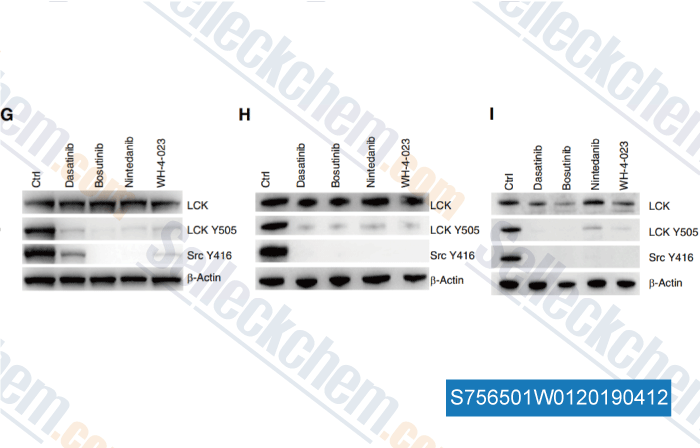|
Toll Free: (877) 796-6397 -- USA and Canada only -- |
Fax: +1-832-582-8590 Orders: +1-832-582-8158 |
Tech Support: +1-832-582-8158 Ext:3 Please provide your Order Number in the email. |
Technical Data
| Formula | C32H36N6O4 |
||||||
| Molecular Weight | 568.67 | CAS No. | 837422-57-8 | ||||
| Solubility (25°C)* | In vitro | DMSO | 100 mg/mL (175.84 mM) | ||||
| Water | Insoluble | ||||||
| Ethanol | Insoluble | ||||||
| In vivo (Add solvents to the product individually and in order) |
|
||||||
|
* <1 mg/ml means slightly soluble or insoluble. * Please note that Selleck tests the solubility of all compounds in-house, and the actual solubility may differ slightly from published values. This is normal and is due to slight batch-to-batch variations. * Room temperature shipping (Stability testing shows this product can be shipped without any cooling measures.) |
|||||||
Preparing Stock Solutions
Biological Activity
| Description | WH-4-023 (KIN001-112, KIN112, Dual LCK/SRC inhibitor) is a potent and orally active Lck/Src inhibitor with IC50s of 2 nM and 6 nM in cell-free assays, respectively. Exhibits >300-fold selectivity against p38α and KDR. Also potently inhibits SIK (IC50 values are 10, 22 and 60 nM for SIK 1, 2 and 3 respectively) and displays selectivity over a range of closely related kinases. | ||||
|---|---|---|---|---|---|
| Targets |
|
||||
| In vitro | WH-4-023 shows little activity on p38 and KDR. [1] |
Protocol (from reference)
| Kinase Assay: |
|
|---|---|
| Animal Study: |
|
References
|
Customer Product Validation

-
Data from [Data independently produced by , , Blood, 2017, 130(25):2750-2761]
Selleck's WH-4-023 has been cited by 26 publications
| NLRP7 maintains the genomic stability during early human embryogenesis via mediating alternative splicing [ Commun Biol, 2025, 8(1):125] | PubMed: 39865169 |
| Generation of a genetically engineered porcine melanoma model featuring oncogenic control through conditional Cre recombination [ Sci Rep, 2025, 15(1):1616] | PubMed: 39794352 |
| Self-renewing human naïve pluripotent stem cells dedifferentiate in 3D culture and form blastoids spontaneously [ Nat Commun, 2024, 15(1):668] | PubMed: 38253551 |
| A transient transcriptional activation governs unpolarized-to-polarized morphogenesis during embryo implantation [ Mol Cell, 2024, 84(14):2665-2681.e13] | PubMed: 38955180 |
| Elucidation of the pluripotent potential of bovine embryonic lineages facilitates the establishment of formative stem cell lines [ Cell Mol Life Sci, 2024, 81(1):427] | PubMed: 39377807 |
| Establishment of porcine embryonic stem cells in simplified serum free media and feeder free expansion [ Stem Cell Res Ther, 2024, 15(1):245] | PubMed: 39113095 |
| Chromatin landscape dynamics during reprogramming towards human naïve and primed pluripotency reveals the divergent function of PRDM1 isoforms [ Cell Death Discov, 2024, 10(1):474] | PubMed: 39562537 |
| Generation of a humanized mesonephros in pigs from induced pluripotent stem cells via embryo complementation [ Cell Stem Cell, 2023, 30(9):1235-1245.e6] | PubMed: 37683604 |
| Modeling human pregastrulation development by 3D culture of blastoids generated from primed-to-naïve transitioning intermediates [ Protein Cell, 2023, 14(5):337-349] | PubMed: 37155315 |
| Short C-terminal Musashi-1 proteins regulate pluripotency states in embryonic stem cells [ Cell Rep, 2023, 42(10):113308] | PubMed: 37858462 |
RETURN POLICY
Selleck Chemical’s Unconditional Return Policy ensures a smooth online shopping experience for our customers. If you are in any way unsatisfied with your purchase, you may return any item(s) within 7 days of receiving it. In the event of product quality issues, either protocol related or product related problems, you may return any item(s) within 365 days from the original purchase date. Please follow the instructions below when returning products.
SHIPPING AND STORAGE
Selleck products are transported at room temperature. If you receive the product at room temperature, please rest assured, the Selleck Quality Inspection Department has conducted experiments to verify that the normal temperature placement of one month will not affect the biological activity of powder products. After collecting, please store the product according to the requirements described in the datasheet. Most Selleck products are stable under the recommended conditions.
NOT FOR HUMAN, VETERINARY DIAGNOSTIC OR THERAPEUTIC USE.
